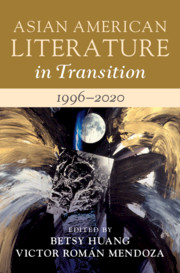Book contents
- Asian American Literature in Transition, 1996–2020
- Asian American Literature in Transition
- Asian American Literature in Transition, 1996–2020
- Copyright page
- Contents
- Illustrations
- Contributors
- Series Preface
- Acknowledgements
- Introduction
- Part I Neoimperialisms, Neoliberalisms, Necropolitics
- Part II Intersections, Intimacies
- Part III Genres, Modalities
- Part IV Movements, Speculations
- Chapter 13 Asian American Literary Studies and the Challenge of Utopia
- Chapter 14 What Is Asian America to Asians?
- Chapter 15 Mixed-Race Asian American Literature at the Turn into the Twenty-First Century
- Chapter 16 Global Asias
- Chapter 17 Finale; Or, Alternative Originaries
- Bibliography
- Index
Chapter 15 - Mixed-Race Asian American Literature at the Turn into the Twenty-First Century
from Part IV - Movements, Speculations
Published online by Cambridge University Press: 27 May 2021
- Asian American Literature in Transition, 1996–2020
- Asian American Literature in Transition
- Asian American Literature in Transition, 1996–2020
- Copyright page
- Contents
- Illustrations
- Contributors
- Series Preface
- Acknowledgements
- Introduction
- Part I Neoimperialisms, Neoliberalisms, Necropolitics
- Part II Intersections, Intimacies
- Part III Genres, Modalities
- Part IV Movements, Speculations
- Chapter 13 Asian American Literary Studies and the Challenge of Utopia
- Chapter 14 What Is Asian America to Asians?
- Chapter 15 Mixed-Race Asian American Literature at the Turn into the Twenty-First Century
- Chapter 16 Global Asias
- Chapter 17 Finale; Or, Alternative Originaries
- Bibliography
- Index
Summary
Asian American literature at the turn of the twentieth century begins with multiracial, transnational, autobiographical Asian American writing by two Eurasian sisters, Edith Maude Eaton and Winifred Eaton, or as they are known through their pen names, Sui Sin Far and Onoto Watana. Yet the flourishing of mixed-race Asian American literature written by multiracial Asian Americans about Asian American experiences has mainly occurred at the turn into the twenty-first century. Like their non-mixed-race writing peers, multiracial Asian American writers are confronted by questions of how much of their art is autobiographical and how much is fiction. This chapter examines the porousness of autobiography and fiction in May-lee Chai’s Hapa Girl (2008), Kip Fulbeck’s Part Asian 100% Hapa (2006), Paisley Rekdal’s The Night My Mother Met Bruce Lee: Observations on Not Fitting In (2000), and Ruth Ozeki’s My Year of Meats. These four texts represent four distinct genres: memoir, travel writing, art book, and novel. Whether fiction or non-fiction, all chart the personal experiences of their mixed-ace authors as multiracial subjects while crafting aesthetic works that contribute to our understanding of multiracial Asian American literature at the turn of the twenty-first century.
- Type
- Chapter
- Information
- Asian American Literature in Transition, 1996–2020 , pp. 294 - 310Publisher: Cambridge University PressPrint publication year: 2021



